Jin Hao
TSegFormer: 3D Tooth Segmentation in Intraoral Scans with Geometry Guided Transformer
Nov 22, 2023Abstract:Optical Intraoral Scanners (IOS) are widely used in digital dentistry to provide detailed 3D information of dental crowns and the gingiva. Accurate 3D tooth segmentation in IOSs is critical for various dental applications, while previous methods are error-prone at complicated boundaries and exhibit unsatisfactory results across patients. In this paper, we propose TSegFormer which captures both local and global dependencies among different teeth and the gingiva in the IOS point clouds with a multi-task 3D transformer architecture. Moreover, we design a geometry-guided loss based on a novel point curvature to refine boundaries in an end-to-end manner, avoiding time-consuming post-processing to reach clinically applicable segmentation. In addition, we create a dataset with 16,000 IOSs, the largest ever IOS dataset to the best of our knowledge. The experimental results demonstrate that our TSegFormer consistently surpasses existing state-of-the-art baselines. The superiority of TSegFormer is corroborated by extensive analysis, visualizations and real-world clinical applicability tests. Our code is available at https://github.com/huiminxiong/TSegFormer.
Fast Model Debias with Machine Unlearning
Nov 03, 2023Abstract:Recent discoveries have revealed that deep neural networks might behave in a biased manner in many real-world scenarios. For instance, deep networks trained on a large-scale face recognition dataset CelebA tend to predict blonde hair for females and black hair for males. Such biases not only jeopardize the robustness of models but also perpetuate and amplify social biases, which is especially concerning for automated decision-making processes in healthcare, recruitment, etc., as they could exacerbate unfair economic and social inequalities among different groups. Existing debiasing methods suffer from high costs in bias labeling or model re-training, while also exhibiting a deficiency in terms of elucidating the origins of biases within the model. To this respect, we propose a fast model debiasing framework (FMD) which offers an efficient approach to identify, evaluate and remove biases inherent in trained models. The FMD identifies biased attributes through an explicit counterfactual concept and quantifies the influence of data samples with influence functions. Moreover, we design a machine unlearning-based strategy to efficiently and effectively remove the bias in a trained model with a small counterfactual dataset. Experiments on the Colored MNIST, CelebA, and Adult Income datasets along with experiments with large language models demonstrate that our method achieves superior or competing accuracies compared with state-of-the-art methods while attaining significantly fewer biases and requiring much less debiasing cost. Notably, our method requires only a small external dataset and updating a minimal amount of model parameters, without the requirement of access to training data that may be too large or unavailable in practice.
Fed-GraB: Federated Long-tailed Learning with Self-Adjusting Gradient Balancer
Oct 23, 2023



Abstract:Data privacy and long-tailed distribution are the norms rather than the exception in many real-world tasks. This paper investigates a federated long-tailed learning (Fed-LT) task in which each client holds a locally heterogeneous dataset; if the datasets can be globally aggregated, they jointly exhibit a long-tailed distribution. Under such a setting, existing federated optimization and/or centralized long-tailed learning methods hardly apply due to challenges in (a) characterizing the global long-tailed distribution under privacy constraints and (b) adjusting the local learning strategy to cope with the head-tail imbalance. In response, we propose a method termed $\texttt{Fed-GraB}$, comprised of a Self-adjusting Gradient Balancer (SGB) module that re-weights clients' gradients in a closed-loop manner, based on the feedback of global long-tailed distribution evaluated by a Direct Prior Analyzer (DPA) module. Using $\texttt{Fed-GraB}$, clients can effectively alleviate the distribution drift caused by data heterogeneity during the model training process and obtain a global model with better performance on the minority classes while maintaining the performance of the majority classes. Extensive experiments demonstrate that $\texttt{Fed-GraB}$ achieves state-of-the-art performance on representative datasets such as CIFAR-10-LT, CIFAR-100-LT, ImageNet-LT, and iNaturalist.
On the Effectiveness of Out-of-Distribution Data in Self-Supervised Long-Tail Learning
Jun 08, 2023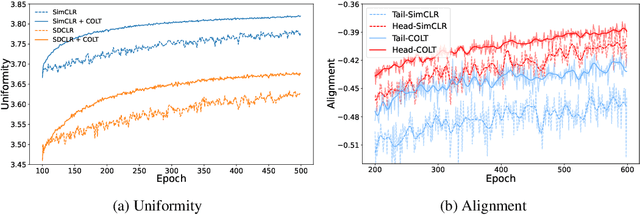
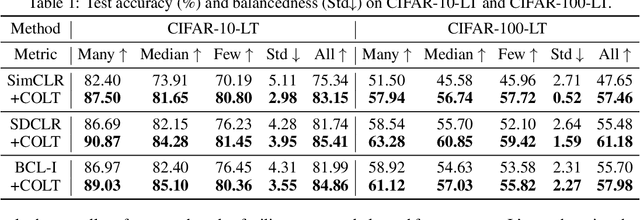
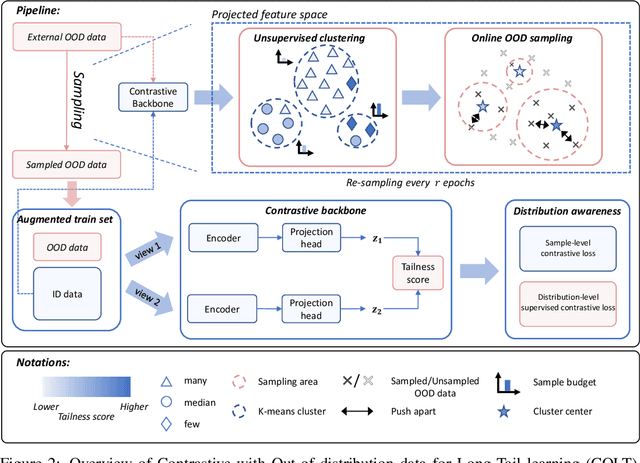
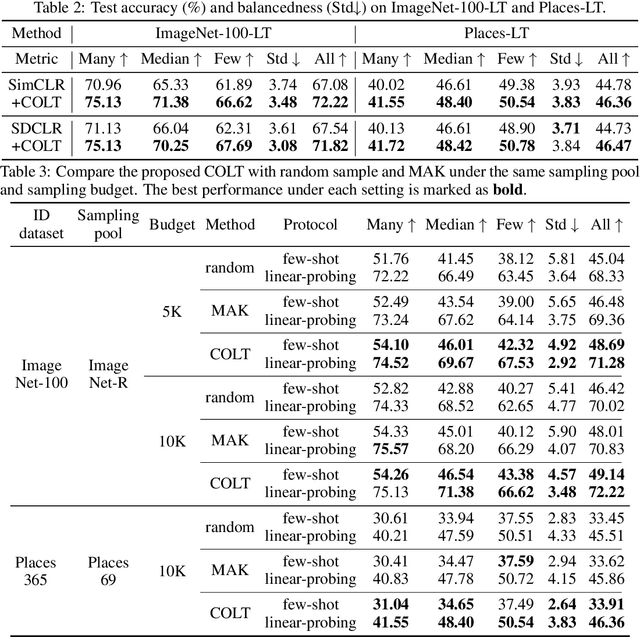
Abstract:Though Self-supervised learning (SSL) has been widely studied as a promising technique for representation learning, it doesn't generalize well on long-tailed datasets due to the majority classes dominating the feature space. Recent work shows that the long-tailed learning performance could be boosted by sampling extra in-domain (ID) data for self-supervised training, however, large-scale ID data which can rebalance the minority classes are expensive to collect. In this paper, we propose an alternative but easy-to-use and effective solution, Contrastive with Out-of-distribution (OOD) data for Long-Tail learning (COLT), which can effectively exploit OOD data to dynamically re-balance the feature space. We empirically identify the counter-intuitive usefulness of OOD samples in SSL long-tailed learning and principally design a novel SSL method. Concretely, we first localize the `head' and `tail' samples by assigning a tailness score to each OOD sample based on its neighborhoods in the feature space. Then, we propose an online OOD sampling strategy to dynamically re-balance the feature space. Finally, we enforce the model to be capable of distinguishing ID and OOD samples by a distribution-level supervised contrastive loss. Extensive experiments are conducted on various datasets and several state-of-the-art SSL frameworks to verify the effectiveness of the proposed method. The results show that our method significantly improves the performance of SSL on long-tailed datasets by a large margin, and even outperforms previous work which uses external ID data. Our code is available at https://github.com/JianhongBai/COLT.
OrthoGAN:High-Precision Image Generation for Teeth Orthodontic Visualization
Dec 29, 2022



Abstract:Patients take care of what their teeth will be like after the orthodontics. Orthodontists usually describe the expectation movement based on the original smile images, which is unconvincing. The growth of deep-learning generative models change this situation. It can visualize the outcome of orthodontic treatment and help patients foresee their future teeth and facial appearance. While previous studies mainly focus on 2D or 3D virtual treatment outcome (VTO) at a profile level, the problem of simulating treatment outcome at a frontal facial image is poorly explored. In this paper, we build an efficient and accurate system for simulating virtual teeth alignment effects in a frontal facial image. Our system takes a frontal face image of a patient with visible malpositioned teeth and the patient's 3D scanned teeth model as input, and progressively generates the visual results of the patient's teeth given the specific orthodontics planning steps from the doctor (i.e., the specification of translations and rotations of individual tooth). We design a multi-modal encoder-decoder based generative model to synthesize identity-preserving frontal facial images with aligned teeth. In addition, the original image color information is used to optimize the orthodontic outcomes, making the results more natural. We conduct extensive qualitative and clinical experiments and also a pilot study to validate our method.
TFormer: 3D Tooth Segmentation in Mesh Scans with Geometry Guided Transformer
Oct 29, 2022Abstract:Optical Intra-oral Scanners (IOS) are widely used in digital dentistry, providing 3-Dimensional (3D) and high-resolution geometrical information of dental crowns and the gingiva. Accurate 3D tooth segmentation, which aims to precisely delineate the tooth and gingiva instances in IOS, plays a critical role in a variety of dental applications. However, segmentation performance of previous methods are error-prone in complicated tooth-tooth or tooth-gingiva boundaries, and usually exhibit unsatisfactory results across various patients, yet the clinically applicability is not verified with large-scale dataset. In this paper, we propose a novel method based on 3D transformer architectures that is evaluated with large-scale and high-resolution 3D IOS datasets. Our method, termed TFormer, captures both local and global dependencies among different teeth to distinguish various types of teeth with divergent anatomical structures and confusing boundaries. Moreover, we design a geometry guided loss based on a novel point curvature to exploit boundary geometric features, which helps refine the boundary predictions for more accurate and smooth segmentation. We further employ a multi-task learning scheme, where an additional teeth-gingiva segmentation head is introduced to improve the performance. Extensive experimental results in a large-scale dataset with 16,000 IOS, the largest IOS dataset to our best knowledge, demonstrate that our TFormer can surpass existing state-of-the-art baselines with a large margin, with its utility in real-world scenarios verified by a clinical applicability test.
AI-enabled Automatic Multimodal Fusion of Cone-Beam CT and Intraoral Scans for Intelligent 3D Tooth-Bone Reconstruction and Clinical Applications
Mar 11, 2022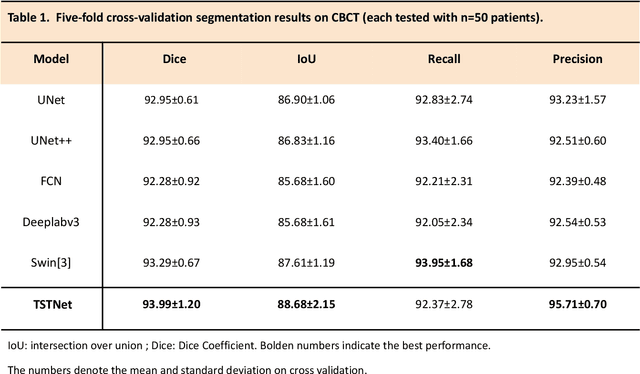
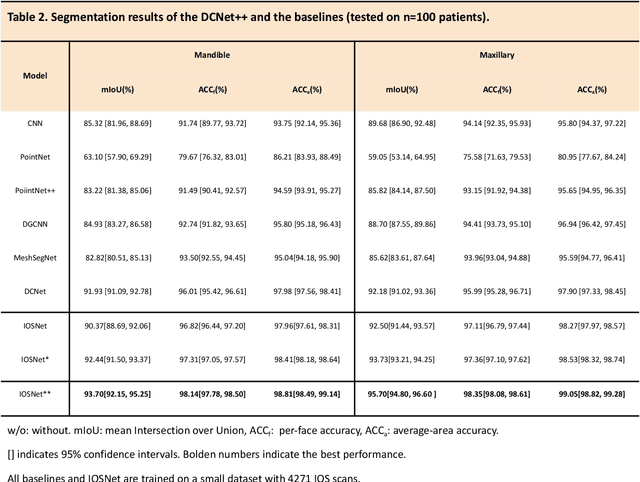


Abstract:A critical step in virtual dental treatment planning is to accurately delineate all tooth-bone structures from CBCT with high fidelity and accurate anatomical information. Previous studies have established several methods for CBCT segmentation using deep learning. However, the inherent resolution discrepancy of CBCT and the loss of occlusal and dentition information largely limited its clinical applicability. Here, we present a Deep Dental Multimodal Analysis (DDMA) framework consisting of a CBCT segmentation model, an intraoral scan (IOS) segmentation model (the most accurate digital dental model), and a fusion model to generate 3D fused crown-root-bone structures with high fidelity and accurate occlusal and dentition information. Our model was trained with a large-scale dataset with 503 CBCT and 28,559 IOS meshes manually annotated by experienced human experts. For CBCT segmentation, we use a five-fold cross validation test, each with 50 CBCT, and our model achieves an average Dice coefficient and IoU of 93.99% and 88.68%, respectively, significantly outperforming the baselines. For IOS segmentations, our model achieves an mIoU of 93.07% and 95.70% on the maxillary and mandible on a test set of 200 IOS meshes, which are 1.77% and 3.52% higher than the state-of-art method. Our DDMA framework takes about 20 to 25 minutes to generate the fused 3D mesh model following the sequential processing order, compared to over 5 hours by human experts. Notably, our framework has been incorporated into a software by a clear aligner manufacturer, and real-world clinical cases demonstrate that our model can visualize crown-root-bone structures during the entire orthodontic treatment and can predict risks like dehiscence and fenestration. These findings demonstrate the potential of multi-modal deep learning to improve the quality of digital dental models and help dentists make better clinical decisions.
 Add to Chrome
Add to Chrome Add to Firefox
Add to Firefox Add to Edge
Add to Edge